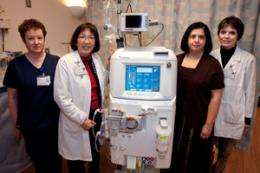Preventing diabetes key step to preventing kidney disease

(PhysOrg.com) -- If there were a one-word message to tell the story of World Kidney Day on March 11, Stanford physicians, researchers, dietitians, nurses would vote for "prevention."
Preventing diabetes will be the focus of exhibits by members of the nephrology division and adult kidney transplant program that will be on display outside the cafeteria at Stanford Hospital & Clinics that day.
At a time when diabetes, the most common cause of chronic kidney disease, is becoming an epidemic in developed countries, Stanford practitioners want their co-workers and visitors to the hospital to know that kidney disease can be detected and managed early.
“To reduce the onset of the primary cause of chronic kidney disease, which is type-2 diabetes, we’re going to have to undertake a lot of educational and lifestyle changes, including diet,” said Glenn Chertow, MD, chief of the nephrology division of the Department of Medicine. A member of the Public Policy Board of the American Society of Nephrology, Chertow opted not to lobby members of Congress in Washington, D.C., on March 11, but to focus instead that day on the education campaign being waged at Stanford Hospital.
Because kidney disease is a so-called silent killer, people tend not to get symptoms until the condition is at an advanced stage. “People with established kidney disease rarely have symptoms, such as shortness of breath for lung disease, or chest pain for heart disease,” Chertow noted. “Instead, the detection of kidney disease requires evaluation of blood and urine samples.”
The major risk factors for type-2 diabetes (which used to be known as adult-onset diabetes) are older age, obesity, family history and ethnicity. Type-2 diabetes is most common among African Americans, Latinos, Native Americans, Asian Americans, Native Hawaiians and Pacific Islanders and is occurring at younger ages.
Because an estimated 40 percent of people who get diabetes will go on to develop chronic kidney disease, practitioners are laser-focused on the unhealthy lifestyles that can promote diabetes. Patsy Obayashi, RD, CDE, a dietitian with the nephrology division, will be available to talk about weight control at the information table on World Kidney Day. “I’ll talk with people about alternate seasoning suggestions like herbs and spices, instead of using salt and heavy sauces.”
Obayashi meets with patients, in group classes or one-on-one, to discuss how they can lose weight. “It’s about portion control, exercise, eating lots of whole grains, vegetables and fruits, and staying away from fat- and sugar-laden foods,” she said. “But it’s difficult to talk with people about something as personal as their eating habits, so it requires a lot of listening and finding out their expectations.”
More than 240 million people worldwide are thought to have diabetes, and that number is expected to double by 2030. The five countries with the highest prevalence of diabetes? India, China, the United States, Russia and Japan.
“I don’t think anybody could have foretold the massive increase in population body weight and obesity over the last 20 years,” Chertow said. “In India a century ago there was widespread famine and starvation. Now, as standards of living have improved, we’re seeing more caloric excesses.” Reversing the alarming worldwide numbers will require “a lot more research into understanding why the kidney scars and fails in the face of diabetes,” he added. “We’ve developed drug therapies which can slow the progression of diabetes-related kidney disease, but we can’t arrest the disease in most cases.”
Chertow said the nephrology division has made key new hires recently, including Vivek Bhalla, MD, Alan Pao, MD, and Julie Yabu, MD, all of whom are working to understand the fundamental mechanisms underlying why people develop kidney diseases associated with diabetes. In addition, the division has begun sending nephrologists to a community hospital in Salinas to offer an outreach diabetes practice there.
Patients with diabetes that has progressed to chronic kidney disease have two treatment options at Stanford Hospital: dialysis and transplantation. “We have a few chronic patients, but the acuity level here is pretty high for most patients, and we treat everyone from neonatal infants to the very elderly,” said Marlys Ludlow, RN, dialysis unit manager.
Dialysis manager assistant Susan Murphy, RN, added that she and her staff travel to all parts of the hospital to perform procedures for hospitalized patients. “We work in the neonatal ICU and in operating rooms,” she said. “We even dialyze patients during liver transplantations.”
Asked about the satisfaction of working with kidney patients, Mojgan Haririfar, NP, manager of the adult kidney transplant program, appeared to speak for many of her colleagues. “Even though it’s a chronic disease, it’s not about, ‘You’re not going to make it,’” she said. “Instead, you have a patient population that you can give hope to. You can help educate them about their options.”














